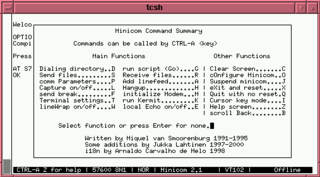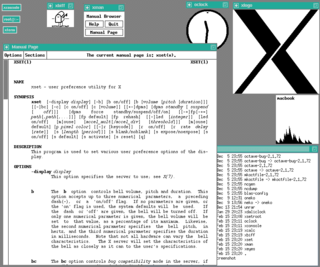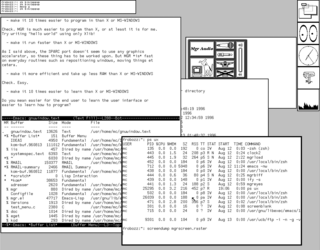Related Research Articles

A bulletin board system (BBS), also called a computer bulletin board service (CBBS), was a computer server running software that allowed users to connect to the system using a terminal program. Once logged in, the user can perform functions such as uploading and downloading software and data, reading news and bulletins, and exchanging messages with other users through public message boards and sometimes via direct chatting. In the early 1980s, message networks such as FidoNet were developed to provide services such as NetMail, which is similar to internet-based email.

A terminal emulator, or terminal application, is a computer program that emulates a video terminal within some other display architecture. Though typically synonymous with a shell or text terminal, the term terminal covers all remote terminals, including graphical interfaces. A terminal emulator inside a graphical user interface is often called a terminal window.

ANSI escape sequences are a standard for in-band signaling to control cursor location, color, font styling, and other options on video text terminals and terminal emulators. Certain sequences of bytes, most starting with an ASCII escape character and a bracket character, are embedded into text. The terminal interprets these sequences as commands, rather than text to display verbatim.

A computer terminal is an electronic or electromechanical hardware device that can be used for entering data into, and transcribing data from, a computer or a computing system. Most early computers only had a front panel to input or display bits and had to be connected to a terminal to print or input text through a keyboard. Teleprinters were used as early-day hard-copy terminals and predated the use of a computer screen by decades. The computer would typically transmit a line of data which would be printed on paper, and accept a line of data from a keyboard over a serial or other interface. Starting in the mid-1970s with microcomputers such as the Sphere 1, Sol-20, and Apple I, display circuitry and keyboards began to be integrated into personal and workstation computer systems, with the computer handling character generation and outputting to a CRT display such as a computer monitor or, sometimes, a consumer TV, but most larger computers continued to require terminals.

In computing, text-based user interfaces (TUI), is a retronym describing a type of user interface (UI) common as an early form of human–computer interaction, before the advent of bitmapped displays and modern conventional graphical user interfaces (GUIs). Like modern GUIs, they can use the entire screen area and may accept mouse and other inputs. They may also use color and often structure the display using box-drawing characters such as ┌ and ╣. The modern context of use is usually a terminal emulator.
Terminal (Terminal.app) is the terminal emulator included in the macOS operating system by Apple. Terminal originated in NeXTSTEP and OPENSTEP, the predecessor operating systems of macOS.
Synchronet is a multiplatform BBS software package, with current ports for Microsoft Windows, Linux, and BSD variants. Past versions also ran on MS-DOS and OS/2, but support for those platforms were dropped in version 3.0.
xterm is the standard terminal emulator for the X Window System. It allows users to run programs which require a command-line interface.

Minicom is a text-based modem control and terminal emulator program for Unix-like operating systems including Cygwin, originally written by Miquel van Smoorenburg, and modeled somewhat after the popular MS-DOS program Telix but is open source. Minicom includes a dialing directory, ANSI and VT100 emulation, an (external) scripting language, and other features. Minicom is a menu-driven communications program. It also has an auto ZMODEM download. It now comes packaged in most major Linux distribution repositories such as Debian, Ubuntu and Arch Linux.
The LK201 is a detachable computer keyboard introduced by Digital Equipment Corporation of Maynard, Massachusetts in 1982. It was first used by Digital's VT220 ANSI/ASCII terminal and was subsequently used by the Rainbow-100, DECmate-II, and Pro-350 microcomputers and many of Digital's computer workstations such as the VAXstation and DECstation families.

In computing, a shell is a computer program that exposes an operating system's services to a human user or other programs. In general, operating system shells use either a command-line interface (CLI) or graphical user interface (GUI), depending on a computer's role and particular operation. It is named a shell because it is the outermost layer around the operating system.

MacTerminal was the first telecommunications and terminal emulation application software program available for the classic Mac OS. MacTerminal enabled users to connect via modem or serial port to bulletin board systems and online services, and to other computers. MacTerminal was capable of emulating the DEC VT100 and other computer terminals.
Red Ryder is a communications and terminal emulation software program released for the Apple Macintosh in 1984. Initially distributed as a shareware, the application offered rich features and configuration settings. Red Ryder was discontinued in 1989 and replaced by White Knight.

Tera Term is an open-source, free, software implemented, terminal emulator (communications) program. It emulates different types of computer terminals, from DEC VT100 to DEC VT382. It supports Telnet, SSH 1 & 2 and serial port connections. It also has a built-in macro scripting language and a few other useful plugins.
Developed specifically for the Apple II series of personal computers, ASCII Express, also known as AE, is a telecommunications software. Throughout the 1980s, ASCII Express garnered a reputation as the preferred programme among telecommunications enthusiasts and users. Its functionality and compatibility with the Apple II made it a staple in the early computer communications era.

ManaGeR or MGR is an early windowing system originally designed and developed for Sun 2/120 workstations in 1984 by Stephen A. Uhler, then at Bellcore.
ZOC is a popular computer-based terminal emulator and Telnet software client for the Microsoft Windows and Apple Macintosh macOS operating systems that supports telnet, modem, SSH 1 and 2, ISDN, serial, TAPI, Rlogin and other means of communication. Its terminal emulator supports Xterm emulation with full colors, meta-keys and local printing, VT102, VT220 and several types of ANSI as well as Wyse, TVI, TN3270, and Sun's CDE. It supports full keyboard remapping, scripting in REXX and other languages, and support for named pipes.

A command-line interface (CLI) is a means of interacting with a computer program by inputting lines of text called command-lines. Command-line interfaces emerged in the mid-1960s, on computer terminals, as an interactive and more user-friendly alternative to the non-interactive interface available with punched cards.
TN3270 Plus is a terminal emulator for Microsoft Windows. It is used for connecting Windows PC users to IBM mainframe, IBM i and UNIX systems via TCP/IP. TN3270 Plus includes terminal emulation for 3270, 5250, VT100, VT220 and ANSI terminals.
The MacintoshCommunications Toolbox, generally shortened to CommToolbox or CTB, was a suite of application programming interfaces, libraries and dynamically loaded code modules for the classic Mac OS that implemented a wide variety of serial and network communication protocols, as well as file transfer protocols and terminal emulations.
References
- ↑ Jim Kimble (May 1992). How to get started with modems. Computer Pub. Enterprises. p. 84. ISBN 978-0-945776-26-0.
- ↑ Dale Bengston (1987). Communication, Control, and Computer Access for Disabled and Elderly Individuals: Software and hardware. Vol. 3. Boston: College-Hill. p. 94. ISBN 978-0-316-89614-6. OCLC 14692845.
- ↑ Tony Diaz (January 3, 2009), "ProTERM v3.1 reclassified as Freeware" (alternate link Archived 2009-05-28 at the Wayback Machine ). Retrieved December 22, 2009.